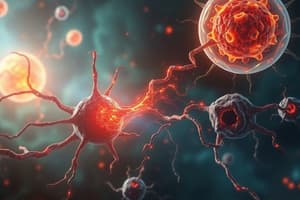Podcast
Questions and Answers
What is one of the main characteristics of fatty change in liver and myocardial cells?
What is one of the main characteristics of fatty change in liver and myocardial cells?
- Absence of mitochondria
- Increased ribosome attachment
- Presence of necrotic tissue
- Accumulation of fat due to hypoxia (correct)
Which type of necrosis is characterized by the preservation of structural outlines of the tissue for several days?
Which type of necrosis is characterized by the preservation of structural outlines of the tissue for several days?
- Liquefactive necrosis
- Necrotizing fasciitis
- Caseous necrosis
- Coagulative necrosis (correct)
In which organ does coagulative necrosis NOT typically occur?
In which organ does coagulative necrosis NOT typically occur?
- Lung
- Liver
- Heart
- Brain (correct)
What are the key indicators of karyorrhexis?
What are the key indicators of karyorrhexis?
Which necrosis type is associated with acidophilic coagulated anucleated cells?
Which necrosis type is associated with acidophilic coagulated anucleated cells?
What causes liquefactive necrosis?
What causes liquefactive necrosis?
What distinguishes caseous necrosis?
What distinguishes caseous necrosis?
Which type of necrosis is often referred to as wet gangrene?
Which type of necrosis is often referred to as wet gangrene?
What characterizes fat necrosis following acute pancreatitis?
What characterizes fat necrosis following acute pancreatitis?
Which process does NOT typically involve apoptosis?
Which process does NOT typically involve apoptosis?
What is the result of karyorrhexis during apoptosis?
What is the result of karyorrhexis during apoptosis?
Which of the following stimuli can initiate apoptosis?
Which of the following stimuli can initiate apoptosis?
What describes the appearance of cells undergoing apoptosis on H&E stained sections?
What describes the appearance of cells undergoing apoptosis on H&E stained sections?
Which category does NOT belong to intracellular accumulations?
Which category does NOT belong to intracellular accumulations?
What is a consequence of activating intracellular proteases during apoptosis?
What is a consequence of activating intracellular proteases during apoptosis?
What happens during the apoptosis of autoreactive T cells?
What happens during the apoptosis of autoreactive T cells?
What primarily causes fatty change (steatosis) in cells?
What primarily causes fatty change (steatosis) in cells?
Which of the following organs is least likely to exhibit fatty change?
Which of the following organs is least likely to exhibit fatty change?
What role do hepatotoxins play in fatty change?
What role do hepatotoxins play in fatty change?
What condition causes macrophages to appear as foamy cells?
What condition causes macrophages to appear as foamy cells?
Which of the following is NOT a mechanism through which free radicals can cause cell injury?
Which of the following is NOT a mechanism through which free radicals can cause cell injury?
Which pigment results from the accumulation of hemoglobin-derived granules?
Which pigment results from the accumulation of hemoglobin-derived granules?
What does pathologic calcification involve?
What does pathologic calcification involve?
What type of cell injury is characterized by clear vacuoles in the cytoplasm?
What type of cell injury is characterized by clear vacuoles in the cytoplasm?
Which species can be generated by the reduction-oxidation reactions involving oxygen?
Which species can be generated by the reduction-oxidation reactions involving oxygen?
What is a visible indicator of fatty change in cells under a light microscope?
What is a visible indicator of fatty change in cells under a light microscope?
Which of the following is least likely to cause fatty change?
Which of the following is least likely to cause fatty change?
What is a consequence of carbon tetrachloride (CCl4) exposure in the liver?
What is a consequence of carbon tetrachloride (CCl4) exposure in the liver?
Which of the following free radicals reacts with thymine in DNA?
Which of the following free radicals reacts with thymine in DNA?
How does mercury cause cellular injury?
How does mercury cause cellular injury?
What role does xanthine oxidase play in free radical generation?
What role does xanthine oxidase play in free radical generation?
Which of the following options is associated with oxidative stress in cells?
Which of the following options is associated with oxidative stress in cells?
What is dystrophic calcification characterized by?
What is dystrophic calcification characterized by?
Where can metastatic calcification occur?
Where can metastatic calcification occur?
What is the primary cause of atrophy?
What is the primary cause of atrophy?
What is a characteristic of hypertrophy?
What is a characteristic of hypertrophy?
Which condition does NOT typically lead to hypercalcæmia?
Which condition does NOT typically lead to hypercalcæmia?
What physiological adaptation is seen in the induction of breast growth?
What physiological adaptation is seen in the induction of breast growth?
What is the likely outcome of extensive nephrocalcinosis?
What is the likely outcome of extensive nephrocalcinosis?
Which of the following is considered a pathologic adaptation?
Which of the following is considered a pathologic adaptation?
Flashcards are hidden until you start studying
Study Notes
Free Radical Mediation of Cell Injury
- Free radicals are unstable molecules with an unpaired electron.
- They readily react with organic and inorganic chemicals.
- Free radicals are implicated in chemical, radiation, and oxygen toxicity, cellular aging, microbial killing, inflammatory damage, and tumor killing.
- They are generated during normal physiological processes and by exposure to radiation and certain chemicals.
- Free radical generation occurs through the reduction of oxygen, enzymatic catabolism, absorption of radiant energy, and reactions with metals like copper and iron.
- Free radicals can damage lipid, DNA, and proteins.
Reversible Cell Injury
- Light microscopic changes include cell swelling, cytoplasmic eosinophilia, and fatty change.
- Ultrastructural changes involve the plasma membrane, mitochondria, endoplasmic reticulum, and nucleus.
Necrosis
- Characterized by morphological changes that follow cell death.
- Manifestations result from enzymatic digestion and protein denaturation.
- Types include coagulative, liquefactive, gangrenous, caseous, and fat necrosis.
Coagulative Necrosis
- Cell structure is preserved, but enzymes are denatured.
- Common in myocardial infarction.
- Occurs in hypoxic tissues except the brain.
Liquefactive Necrosis
- Results from bacterial or fungal infection.
- Occurs in the CNS due to hypoxia.
- Leads to the formation of a liquid mass.
Gangrenous Necrosis
- Ischemic coagulative necrosis with superimposed infection.
- Often referred to as "wet gangrene".
Caseous Necrosis
- Characterized by a cheese-like appearance.
- Seen in tuberculosis.
- Microscopically composed of granular debris within granulomatous inflammation.
Fat Necrosis
- Caused by the release of pancreatic enzymes.
- Occurs in the peritoneum following pancreatitis.
- Leads to the hydrolysis of triglyceride esters within fat cells.
Apoptosis
- Programmed cell death.
- Seen in physiological and pathological conditions.
- Apoptosis involves single cells or clusters of cells and can be initiated by withdrawal of growth factors, engagement of specific receptors, injury, and intrinsic protease activation.
Intracellular Accumulations
- Normal cells may accumulate abnormal substances.
- Accumulations can be normal endogenous substances, abnormal endogenous substances, or abnormal exogenous substances.
- Accumulations may be harmful or injurious.
Fatty Change (Steatosis)
- Accumulation of triglycerides within cells.
- Most commonly seen in the liver, although it can occur in other organs.
Cholesterol and Cholesterol Esters
- Accumulation can lead to fatty cells, atherosclerosis, and xanthomas.
Proteins
- Uncommon accumulation, but can be observed in glomerular diseases.
Glycogen
- Accumulates in cases of abnormal glucose or glycogen metabolism.
Pigments
- Colored substances either exogenous or endogenous.
- Examples include melanin, hemosiderin.
Pathologic Calcification
- Abnormal deposition of calcium salts.
- Dystrophic calcification occurs in dead or dying tissues.
- Metastatic calcification occurs in normal tissues due to hypercalcemia.
Cell Adaptations of Growth and Differentiation
- Cells adapt to changes in their environment.
- Physiological adaptations are responses to hormones or endogenous chemicals.
- Pathological adaptations are often responses to stress or injury.
Atrophy
- Shrinkage in cell size.
- Can involve the entire organ.
- Causes include decreased workload, loss of innervation, diminished blood supply, inadequate nutrition, loss of endocrine stimulation, and aging.
Hypertrophy
- Increased cell size.
- Results from increased synthesis of structural proteins and organelles.
- Associated with increased workload.
Studying That Suits You
Use AI to generate personalized quizzes and flashcards to suit your learning preferences.



